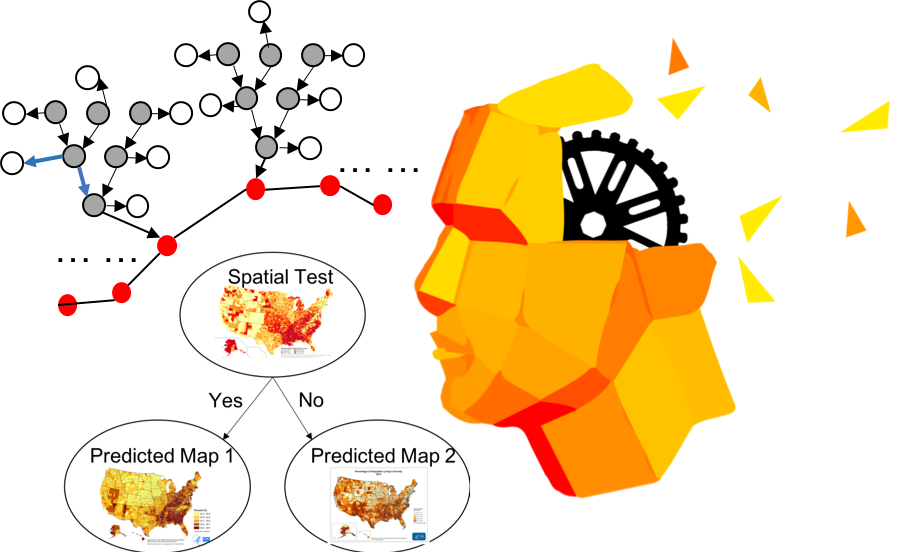Zhe Jiang Homepage
Interpretable Machine Learning
The field of data science has achieved tremendous success over the last decade, not only in business but also in science and engineering.
The data-driven approach has been recognized as the "fourth paradigm" of scientific discovery (after experimental, theoretical, and computational simulation).
However, when solving interdisciplinary scientific problems or high-stake decision making applications, a purely data-driven approach often faces a significant gap
in lacking interpretability and consistency with existing theories and knowledge in the discipline, as shown by the famous Google Flu Trend example. This project aims to fill the gap by utilizing
disciplinary knowledge to guide data-driven models to enhance interpretability, consistency, as well as prediction accuracy. Specifically, we
study the problem in the context of spatial structured models for geoscience applications. We investigate the utilization of disciplinary knowledge
in constructing a transparent (intrinsically interpretable) model architecture and explore efficient algorithms for model learning and inference. Proposed approaches are validated
with interdisciplinary applications in hydrology. The project, if successful, will contribute towards the next generation water resource management for
the U.S. in the 21st century. Proposed research can not only improve the situational awareness for disaster response agencies but also enhance the flood
forecasting capabilities of the National Water Model. Proposed algorithms will be implemented into open source tools that will enhance the research infrastructure
for geoscience communities. Educational activities include curriculum development, mentoring a broad group of high school students in data science seminars
at Alabama Computer Science Camps, as well as year-long project for a selected number of high school students for regional Science Fair competition.

Publications:
- Zhe Jiang, Arpan Man Sainju, "A Hidden Markov Tree Model for Flood Extent Mapping in Heavily Vegetated Areas based on High-Resolution Aerial Imagery and DEM: A Case Study on Hurricane Matthew Floods", International Journal of Remote Sensing (IJRS), Taylor and Francis Group, 2020 (accepted)
- Arpan Man Sainju, Wenchong He, Zhe Jiang, "A Hidden Markov Contour Tree Model for Spatial Structured Prediction", IEEE Transactions on Knowledge and Data Engineering (TKDE), 2020 (accepted)
- Zhe Jiang, "Spatial Structured Prediction Models: Applications, Challenges, and Techniques", IEEE Access, V8, 38714-38727, 2020
- Zhe Jiang, Miao Xie, Arpan Man Sainju, "Geographical Hidden Markov Tree", IEEE Transactions on Knoweldge and Data Engineering (TKDE), 2019, PDF
- Zhe Jiang, Arpan Man Sainju, "Hidden Markov Contour Tree: A Spatial Structured Model for Hydrological Applications", ACM SIGKDD International Conference on Knowledge Discovery and Data Mining (KDD), Anchorage, AK, USA, 2019 PDF, Source Codes
- Miao Xie, Zhe Jiang, Arpan Man Sainju, "Geographical Hidden Markov Tree for Flood Extent Mapping", ACM SIGKDD International Conference on Knowledge Discovery and Data Mining (KDD), London, UK, 2018 PDF
- Zhe Jiang, Shashi Shekhar, Xun Zhou, Joseph Knight, and Jennifer Corcoran. "Focal-test-based spatial decision tree learning." IEEE Transactions on Knowledge and Data Engineering (TKDE) 27, no. 6 (2015): 1547-1559.
- Zhe Jiang, Shashi Shekhar, Xun Zhou, Joseph Knight, and Jennifer Corcoran. "Focal-test-based spatial decision tree learning: A summary of results." In IEEE 13th International Conference on Data Mining (ICDM), pp. 320-329. IEEE, 2013.
- Zhe Jiang, Shashi Shekhar, Pradeep Mohan, Joseph Knight, Jennifer Corcoran. "Learning spatial decision tree for geographical classification: a summary of results". In Proceedings of the 20th ACM SIGSPATIAL International Conference on Advances in Geographic Information Systems (GIS), pp 390-393, 2012.

